Throwbacks: Finding Beijing Flavor in Nostalgic Summer Foods and Drinks
Project Pengyou summer intern, Xie Xin, reminisces about summer snacks and drinks local to Beijing.
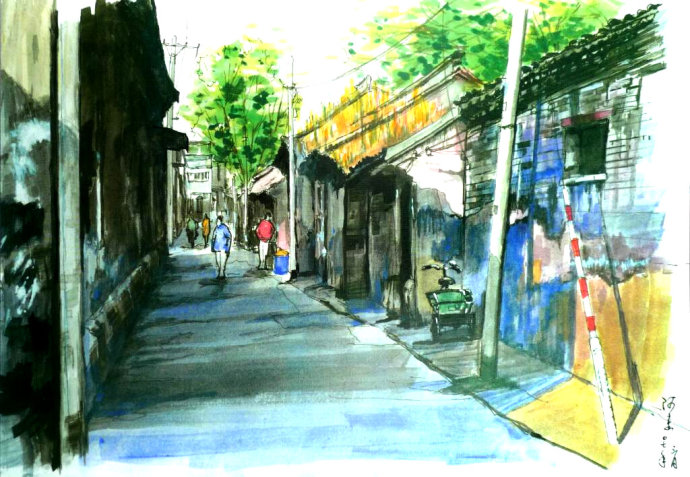
It is summer time in Beijing again, and nothing feels better than having cold summer foods and drinks to beat the heat. There are lots of imported options in this international metropolis from magnum bars, Oreo-flavored ice cream, even Ben & Jerry’s; but perhaps even better is opting to try something with nostalgic local flavor!
Summer intern Xin introduces to you seven summer foods and drinks in Beijing that are nostalgic to Beijing natives, and presents 京味儿/Jing Weir (Beijing flavor) to Pengyous.
1. 北冰洋汽水/ Beibingyang Qishui (Arctic Ocean Soda)
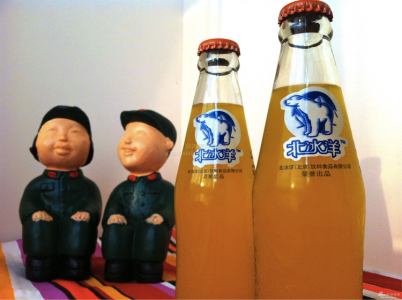
Type: soda
Where to find it: small convenience stores and restaurants in Beijing
Similar to: Fanta
Decade: 50s
Beibingyang is a fizzy drink beloved by Beijingers for it’s ultra-low sugar content and simple, subtle design. It was first produced in the 1950s by the former Beijing New Ice Making Factory, but it was not until 1956 that Beibingyang was able to mass-produce the soda, making it available to the public at 10 cents per bottle. With the average Beijing family income per month in the 1950s around 20 yuan, Beibingyang was quite a luxury for many people. Even so, it was hard to resist that refreshing coolness in the height of summer. Beibingyang reached its peak in the 1980s after China’s Reform and Opening Policy cause wealth to rise, thus making Beibingyang more affordable for the average person. However, it faced fierce competition from world’s leading soda brands that also came into China at that time. As a result, Beibingyang disappeared from shelves for over a decade. Fortunately, it came back in 2011 with the same glass bottles and mandarin-orange flavor as the 1950s, although the company also developed new flavors to meet people’s diversified tastes, such as loquat and plum.
2. “双棒儿”雪糕/ “Shuang Bangr” Xuegao (Two-Stick Ice Cream Bar)
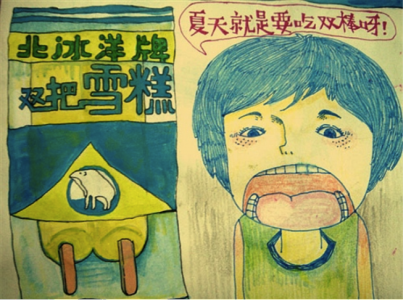
Type: ice cream bar
Where to find: convenience stores and supermarkets in Beijing
Similar to: Twin pops
Decade: 50s
Shuang Bangr (which directly translates to “two-stick”) is a milk-flavored ice cream bar that has two wooden sticks instead of one like most ice cream bars. Shuang Bangr is not overly sweet and contains higher quality milk powder than the average ice cream bar. Also produced by the Beijing New Ice Making Company and later by Beibingyang Co., Shuang Bangr suffered a similar fate as Beibingyang. It also transformed from a luxury to a common treat and then disappeared before later re-surfacing. Back in the old days, Shuang Bangr was really popular with kids due to the fact that it can be easily shared. Two friends could combine their limited pocket money to buy one Shuang Bangr, split it in half, and each take half to eat while walking back home from school together; a little money and a simple joy shared between friends.
3. 冰葫儿/Bing Hur (Ice Gourd)
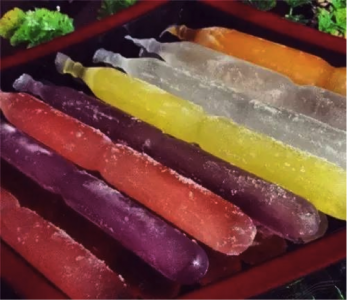
Type: frozen juice
Where to find: convenience stores and supermarkets
Similar to: Fla-Vor-Ice
Decade: 70s and 80s
Bing Hur is a type of frozen juice that is contained in a plastic tube-shaped bag that resembles a really thin gourd. Despite its current appearance, which actually gives it a new name, 棒棒冰/Bangbang Bing (Bar Ice) in many parts of China, the earliest Bing Hur back in the 70s and 80s had the exact appearance of a gourd. You can cut or bite the plastic bag open from the top, or (in the more common way of eating a Bing Hur) freeze it before ripping it open from the middle to share with friends, similar to Shuang Bangr. It was always a kid-favorite, although it was sweeter than Shuang Bangr, it had more color options, and was cheaper.
4. 老北京瓷罐酸奶/Lao Beijing Ciguan Suannai (Traditional Beijing Yogurt in Porcelain Jars)
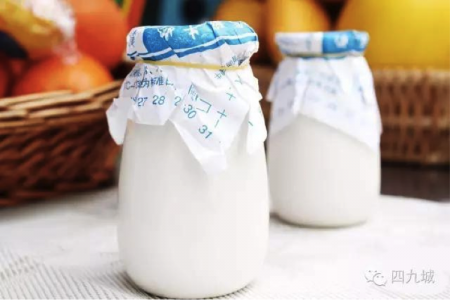
Type: yogurt
Where to find: convenience stores in Beijing
Similar to: Go-gurt
Decade: 80s
Lao Beijing Ciguan Suannai is locally produced yogurt sold in recycled porcelain jars and slightly similar to the popular drinkable yogurt in the US, go-gurt. The first Lao Beijing Suannai in porcelain jar was produced around 1980. The factory initially chose to use porcelain jars just for the sake of convenience, because they could easily buy the jars from a factory at Zhangjiakou at a reasonable price. The yogurt in porcelain jars quickly became so popular that many stores wanted to sell them and had to compete with each other to get more every day. Unfortunately, the popularity did not last long. As the mass production of yogurt in plastic bags and paper boxes began, the market quickly shrank for Lao Beijing Ciguan Suannai and in 2009 news even came out that Ciguan Suannai would no longer be produced. Fortunately, Chinese netizens followed closely with the news and even started petitions to save Ciguan Suannai. As a result, we can still find it everywhere in Beijing today.
5. 老白牌儿啤酒/Lao Baipair Pijiu (The Old White-Brand Beer)

Type: beer
Where to find: convenience stores, supermarkets, and restaurants in Beijing
Similar to: Pabst Blue Ribbon
Decade: 40s
Lao Baipair Pijiu is actually a nickname for Beijing Beer, a local brand of beer that is lighter with less alcohol content compared to regular beer. The brand was founded with the name Beiping Pijiu in 1941, and it was the first beer brand in Beijing’s history. After the founding of the PRC, Beiping Pijiu changed its name to Beijing Pijiu, but people just called it Lao Baipair because of its unique white brand on the beer bottles. In the 80s and 90s, Beijing Beer and another brand called 五星/Wuxing (Five Stars) were the only brands that Beijingers would drink. The two companies divided the market by the central axis of the city, with Beijing Beer being mainly sold in the east part. Like other old brands, Lao Baipair also went through a hard time competing with foreign brands in the new millennium, but it has rebuilt its reputation through new business strategies and found its place in the market.
6. 酸梅汤/Suanmei Tang (Sour Plum Soup)
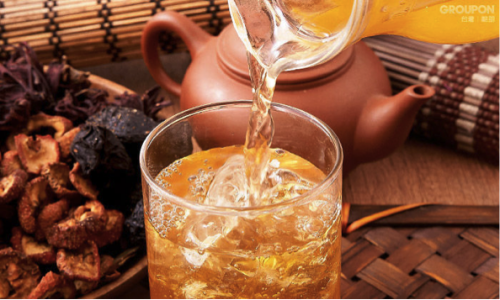
Type: plum juice
Where to find: convenience stores, supermarkets, and restaurants in Beijing
Similar to: Prune Juice
Decade: early 18th century
Suanmei Tang is a traditional Chinese beverage made from smoked plum, hawthorn, sweet osmanthus flower, liquorice, and crystal sugar similar to the way traditional Chinese medicine is made. This plum-flavored beverage has enjoyed a long history that can be traced back to the Shang and Zhou Dynasties (c. 1600 B.C. — 256 B.C.). The current recipe of Suanmei Tang was developed by the royal teahouse in the Qing Dynasty to help the royal family better adjust to the weather in Beijing and keep fit. The recipe later made its way out of the palace and the public fell in love with it. The street vendors that sold Suanmei Tang at that time would knock a pair of bronze bowls against each other to announce to people passing by that they were selling Suanmei Tang. While you can hardly find vendors doing this in Beijing nowadays, you can still find Suanmei Tang in almost every restaurant in Beijing, and companies that produce Suanmei Tang have become popular as well.
7. 果子干/Guozi Gan (Dried Fruit)
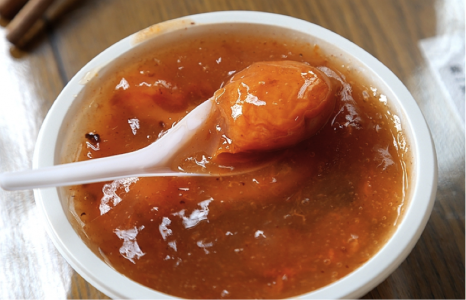
Type: sweet fruit cup
Where to find: a few old restaurants like 爆肚张/Baodu Zhang
Similar to: Dole fruit cups
Decade: Qing Dynasty
Guozi Gan is made by soaking dried persimmons, raisins, pears, and apricots in warm water for a while before adding slices of fresh lotus roots and sweet osmanthus flower sauce. Guozi Gan can be traced back to Qing Dynasty as a winter snack. At that time, fresh fruit was not available during the winter, so people would dry fruit to make into Guozi Gan to eat during winter. Later, when electricity made preserving fresh fruit possible, people enjoyed the cold treat in the summer as well. Guozi Gan used to be sold by the same street vendors who sold Suanmei Tang and other summer snacks, so whenever people heard the tell-tale knocking sounds of bronze bowls, they would rush out to get some (much like the sound of the ice-cream truck in the United States). The street vendors actually got a name of 打冰盏儿的/Da Bingzhanr De (the icy bowl knockers) for the sounds they made while strolling the streets. Guozi Gan is not as popular as it once was due to the availability of fresh fruit all year round, yet, its cool, sweet, and crisp taste make it a must-have.
Have you tried any of these snacks on the list? Are there more Beijing summer snacks we missed? Leave a comment and tell us!
Amazing post!! 🙂
still need to try 2 of these!